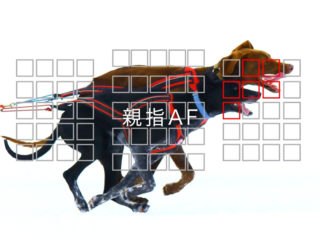It has been 8 years since I started taking pictures with a DSL camera, and although my career is young, I have been a consistent Pentax DSLR camera user, believing in and using thumb-AF, which I learned from Mr. Seiya Nakai’s introductory book when I started taking pictures.
As those who have operated SLR cameras know well, most cameras have two functions assigned to the shutter release button by default: “half-press = AF” and “full-press = release”. Thumb-AF is the use of separating the former from the shutter button and assigning it to another button at the right thumb.
For a detailed explanation, for example, see this site.

I shoot a variety of subjects, but as a Pentax user, I rarely chase moving objects and only go out a few times a year to take pictures of train scenery. When I take pictures of trains, I rarely use AF-C to follow the movement of the train, but rather focus on a specific spot in advance (so called “Pin-On-The-Ground”) and wait for the train to come along. Since the focus position does not move, in order to increase the probability of getting the train in focus exactly as I want, I take a series of shots and select the “hit” one out of them.
I often want to take pictures of railroad scenery by following Mr. Nakai’s teachings, and I often want to take pictures of the subject at the intersection of the quadrants and diagonals in a “Reilman composition,” or at a more outer corner of the picture. In this case, the PENTAX K-3III SLR is forced to focus outside the range of the AF distance-measuring point, so the natural solution is to use a POTG AF system. Since thumb-AF and the POTG are so compatible, I have been doing so without any doubts.
This is a re-posting of a photo from late last month, with the following composition.
BTW,
While continuing to use Pentax equipment, I now have Lumix S5, G99, GF10 and other Panasonic mirrorless DSL equipment on hand, and I am using these more and more frequently. They can freely measure the AF distance anywhere in the frame, so there is no need to place a pin on the frame. In fact, AF-C allows you to “keep focusing” on the subject dynamically, so in theory, you can continue to take many “hit” photos with continuous shooting.
*The AF-C accuracy of the LUMIX cameras I own is only “so-so” in my experience, so I cannot be overconfident, but compared to the Pentax cameras (…self-restraint)
When I think again about what the advantage of thumb-AF is, I understand that it means that focus lock is flexible (in fact, the positional pin is one of the patterns). When you want to take several pictures while keeping the focus position once set, it takes some getting used to and concentration to keep the shutter release button pressed halfway to lock the focus, but with thumb-AF, you just release the thumb from the button and the focus is locked immediately (AF never activates). You can forget about focusing and concentrate on fine-tuning the composition and timing.
However, this is also a needless worry for mirrorless DSL cameras, which can focus anywhere you want. You can place the distance-measuring point where you want from the beginning by touching it with your finger on the monitor LCD or using the “gri-gri” (what is that button called?).
In other words, there is no particular advantage to using thumb-AF on mirrorless DSL. To take it one step further, if you are shooting a series of dynamic images in AF-C, you may rather consider a situation where the shutter half-press AF is more advantageous.
With thumb-AF, both the right thumb and index finger (shutter release) must be kept pressed in, and the remaining three fingers of the right hand tend to have a halfway grip. Since force is applied from two different directions, albeit slightly, it is easy for the camera to move unintentionally, causing blurred pictures (I am ashamed to admit that I do this from time to time).
On the other hand, in shutter half-press AF, only the index finger moves, and whether you grip it firmly or softly, you don’t have to think about your right hand getting in the way.
So, my faith in thumb-AF is a little shaken.
When using PENTAX K-3III, I still think thumb AF is more advantageous, and I cannot easily switch to shutter half-press AF because it is simply a matter of getting used to it. It is also troublesome to use different controls for different equipment, so my conclusion is that I will most likely continue to use the mirrorless model with thumb-AF.
However, I’m feeling a bit confused these days. Hmmm.



